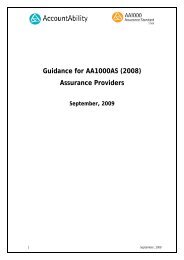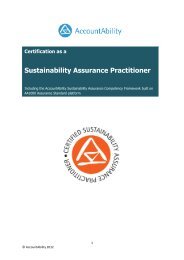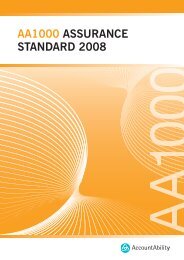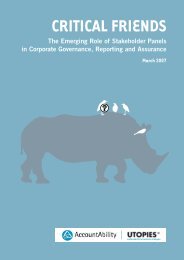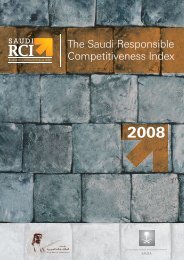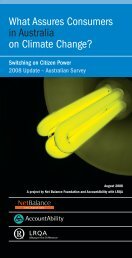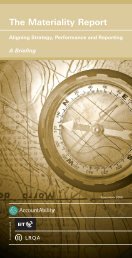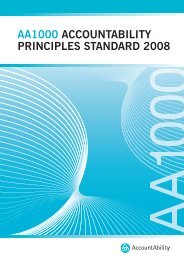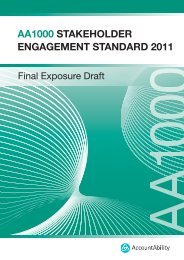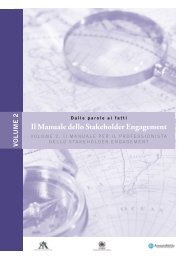The Stakeholder Engagement Manual Volume 2 - AccountAbility
The Stakeholder Engagement Manual Volume 2 - AccountAbility
The Stakeholder Engagement Manual Volume 2 - AccountAbility
Create successful ePaper yourself
Turn your PDF publications into a flip-book with our unique Google optimized e-Paper software.
Strengthen Capacities for <strong>Engagement</strong><br />
P12: DEVELOPING THE INTERNAL SKILLS AND CHARACTERISTICS NEEDED FOR STAKEHOLDER ENGAGEMENT<br />
9<br />
For more on boundary spanners, please also see: Sean Ansett's article in the <strong>AccountAbility</strong><br />
Forum No.6 <strong>Stakeholder</strong> <strong>Engagement</strong>, London, 2005.<br />
10<br />
See also the Placer Dome case study in <strong>Volume</strong> 1: :<strong>The</strong> Guide to Practitioners' Perspectives on<br />
<strong>Stakeholder</strong> <strong>Engagement</strong>", p29, box 2.4.<br />
BACKGROUND<br />
When deciding to engage with stakeholders, it is vital that you consider what<br />
internal skills are required. Many path-breaking engagement processes involve or<br />
are driven by what Sean Ansett calls ‘boundary spanners’. Th ese are individuals<br />
within organisations that establish links across organisational boundaries,<br />
identify threats and opportunities, embed insights back into the organisation and<br />
make complex multi-stakeholder collaboration possible 9 . However, engagement<br />
processes are likely to involve a broad variety of people with diff erent levels of<br />
expertise and experience in the area. Th is means eff orts to develop stakeholder<br />
engagement related skills should not only focus on sustainability and CSR<br />
managers or stakeholder engagement specialists, but also on general managers<br />
across functions.<br />
Th ere is no generic stakeholder engagement skill-set, as diff erent expertise and<br />
experience may be needed to engage with public policy makers, supply chain<br />
workers, or to moderate an internet discussion with consumer activists for<br />
example. However, a basic range of skills and characteristics can be identifi ed.<br />
Sometimes it may be practical to develop these skills with people who are dealing<br />
directly with stakeholders, but are not ‘engagement specialists’. In other cases, it<br />
may be more suitable to draw on the expertise of practitioners from established<br />
professions such as labour relations, lobbying, public aff airs, and market<br />
research 10 . Apart from skills, another key contributor to successful engagement<br />
is credibility. For example, facilitators who are from a similar background to<br />
the stakeholder group may be better able to understand cultural issues and put<br />
stakeholders at ease.<br />
In addition to the ability to engage successfully, being knowledgeable on relevant<br />
issues and being credible, benefi cial skills include project management and<br />
analytical skills, as well as certain personality traits. <strong>The</strong> engagement skills and<br />
characteristics map on the following page illustrates this required combination<br />
of skills and characteristics. <strong>The</strong> requirements associated with each of these skills<br />
and characteristics are described in further detail below, along with possible<br />
sources for improvement.<br />
Telefónica’s Internal Training<br />
Telefónica’s CSR and Human Resources department are working together to integrate CSR<br />
and stakeholder issues into internal training courses for employees from various departments<br />
and business functions. A focus lies on creating an awareness of the link between brand,<br />
reputation and social responsibility. This part of the training is tied to an introduction to<br />
Telefónica’s values, policies and vision. Apart from the direct benefi ts of increased awareness<br />
among employees, it also promotes an understanding of Telefónica’s CSR strategy and positioning<br />
as a source of help for identifying risks, solving problems and generating opportunities<br />
across the company.



